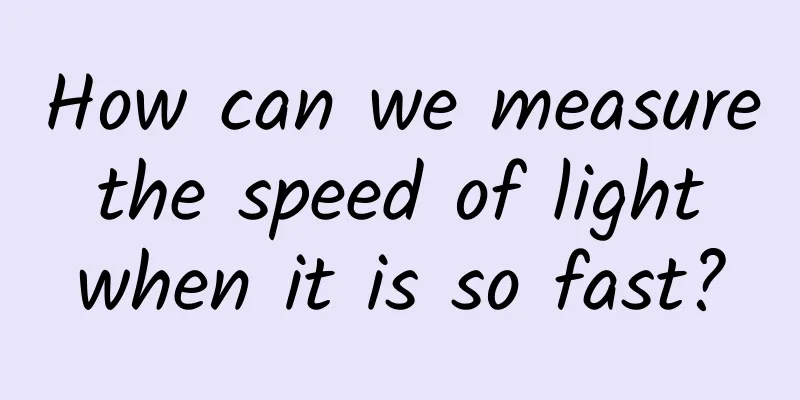How can we measure the speed of light when it is so fast?

|
The speed of light in a vacuum can be said to be the maximum speed of objects in nature. The speed of light currently recognized by the scientific community is 299792.458 km/s, which means that in one second, light can travel 299792.458 kilometers, which is approximately equal to 7.48 laps around the earth's equator. Since light "runs" so fast, how did scientists get such precise numbers? How was the speed of light measured? Galileo - The first person to realize that light has a speed Before the 17th century, people always thought that the speed of light was infinite, and Kepler and Descartes were both convinced of this. But Galileo put forward a different view, believing that although the speed of light is very fast, it is still limited and can be measured. In order to confirm his conjecture, Galileo designed the world's first experiment to measure the speed of light in 1607. He asked two people, A and B, to stand on the top of two mountains 1.5 kilometers apart, hoping to use the time difference between the two mountains to see the lights to measure the speed of light. However, because the time interval was too short, it was impossible to measure accurately. In the end, Galileo's experiment ended in failure, but he opened the door to the truth of human measurement of the speed of light. Romer - the first person to make astronomical measurements Jupiter's revolution period is 12 years, and every time Jupiter's satellite orbits Jupiter, an "eclipse" will occur when it enters Jupiter's shadow. This is similar to a lunar eclipse, and when Jupiter moves between the satellite and the sun, Jupiter's "satellite eclipse" will occur. But in fact, people see that the time of satellite eclipses is constantly changing. This obviously shows that the positions of the Earth and Jupiter are constantly changing, and the distance between the Earth and Jupiter is not a constant value. Not only that, the occurrence of this phenomenon is also related to the speed of light. In 1676, Danish astronomer Roemer conducted long-term observations of this satellite of Jupiter. He found that the actual time of satellite eclipses was more than ten minutes later than the estimated time. He believed that this was because the distance between the earth and Jupiter was gradually increasing, so the time it took for light to reach the earth was also correspondingly extended. Therefore, Roemer deduced that the speed of light was limited. He also calculated that the time required for light to travel a distance equal to the radius of the earth's orbit was 11 minutes. Romer predicted that the eclipse of Jupiter's moon, which was supposed to occur at 5:25:45 a.m. on November 9, 1676, would be delayed by 10 minutes. The final observation results confirmed Romer's conjecture. After repeated verification and correction, the famous scientist Huygens used Romer's theory to calculate the first speed of light in the history of science: 214,000 km/s. Fizeau - Explorer of Ground Experiments The first person to measure the speed of light on the ground was the French physicist Fizeau, who designed an ingenious device - a rotating gear - to measure the speed of light. The "rotating gear" consists of a gear, a mirror and a semi-transparent mirror. After the light source is emitted, it will be reflected by the semi-transparent mirror to the mirror, and the mirror will reflect the light into the observer's eyes. In the middle, there is a gear. When it starts to rotate, it will cut the light reflected into the human eye into segments, so people will see flashes. The speed of each flash can be calculated by the rotation speed of the gear and the distance of the light. Although this method has its shortcomings, it is a pioneering move in the history of light speed measurement and laid the foundation for subsequent measurement work. Michelson - the master of light speed measurement Michelson began to study the measurement of the speed of light in 1879, which lasted for about 50 years until 1926. He summarized the shortcomings of his predecessors and designed the "rotating octahedral prism method" to measure the speed of light. In the "rotating octahedral prism method", Michelson used a regular octahedral steel prism to replace the rotating plane mirror in the rotating mirror method, thereby extending the path of light; and replaced the gear speed in the gear method with the accurately measured prism speed, thereby reducing the error in time measurement. In this experiment, Michelson calculated that the speed of light is 299796km/s, which was considered the most accurate record at the time, and Michelson became the winner of the 1907 Nobel Prize in Physics. A new era in light speed measurement After Michelson, the 250-year-long exploration of the speed of light came to a temporary halt. In 1929, the measurement of the speed of light entered a new stage. New experimental techniques and methods emerged one after another, and the speed of light became more and more precise, eventually becoming a defined value in the physics community. ➡In 1937 and 1941, Anderson of the United States measured the speed of light twice, and finally used the Kerr effect to measure the speed of light to be 299,776 km/s. ➡In 1949, Aslakson used radar to measure the speed of electromagnetic waves, and the result was 299792km/s. ➡In 1952, British experimental physicist Fromm used a microwave interferometer to measure the speed of light with extremely high precision. The speed of light measured by this method was 299792km/s. ➡In 1960, the laser came into being. ➡In 1972, Evenson and others from the US Bureau of Standards measured the speed of light to be 299792.458 km/s by measuring the laser frequency and the wavelength of light in a vacuum. This value was eventually adopted as an internationally recommended value by the Fifth Advisory Committee on the Definition of the Meter held in 1973 and the Fifteenth General Conference on Weights and Measures held in 1975. After more than 300 years of measurement, the speed of light has finally been determined. In the process of exploration, scientists perfectly combined theory and practice, calculation and measurement, and finally obtained a precise value for the speed of light. The determination of the speed of light not only affects the definition of the unit "meter", but also provides help for further research. Standard units such as the speed of light and "meter" may seem ordinary, but they have witnessed the progress of human civilization. Science has no limits, and the journey of human exploration of the world has just begun. |
>>: It’s been ten years. Do you still remember the little rabbit that “broke into” the Moon Palace?
Recommend
Traffic diversion and retention of Douyin private domain traffic pool
I have personally been focusing on the operation ...
TIKTOK won’t install? It costs 10 yuan to install it once. This information gap is too profitable.
TIKTOK won’t install? It costs 10 yuan to install...
Meizu M6 hands-on experience: Smartphones under 1,000 yuan can also perform well
Since the advent of the Meizu brand, the Meizu No...
How do web game ads achieve conversions?
Web games, which have always given people the imp...
Galaxy Internet TV is about to rise to become one of the three largest internet TVs in the world
At present, the seven Internet TV platforms that ...
Unboxing the 4th generation Apple TV retail version: The new Siri remote control is a great experience
Since its release in September, we have known tha...
Which company providing SEO optimization services in Pingliang is better? How to choose?
Nowadays, due to the increasing bidding costs, ma...
The world is so big, I want to eat – How can I eat healthier when I travel on vacation?
Author: Li Haijie: Hebei Provincial Key Laborator...
Hydrogen drives the future, South Korea is fully betting on hydrogen fuel technology
Hydrogen fuel cell vehicles use hydrogen as fuel ...
How far can a telescope see? There is no farthest, only farther...
"How far can your telescope see?" This ...
What are some common problems you may encounter in website maps?
Friends who do website SEO optimization may be fa...
Analysis of Perfect Diary’s private domain traffic operations!
This article explains why Perfect Diary’s private...
Electric vehicle industry circle of friends advertising marketing strategy
1. Market background analysis Market development ...
How to avoid Android startup stack trap
I. Problem and Background The mutual linkage and ...
WeChat Tips: From XX Challenge to XX Red Packet, the Next Hot Spot in WeChat Moments
In two months, the Chinese New Year will come, an...









